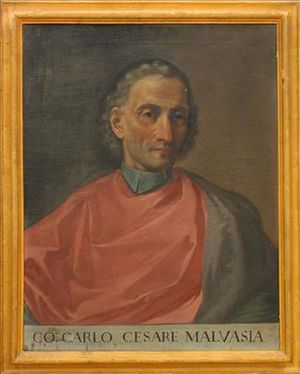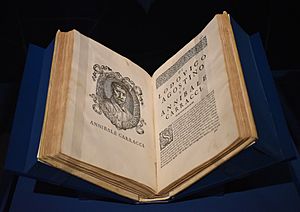Carlo Cesare Malvasia facts for kids
Quick facts for kids
Doctor
Carlo Cesare Malvasia
|
|
|---|---|

Carlo Cesare Malvasia
|
|
| Born | December 18, 1616 |
| Died | 9 March 1693 (aged 76) |
| Nationality | Italian |
| Other names | Ascoso |
| Alma mater | University of Bologna |
| Occupation | Catholic priest, historian, university teacher, epigraphist |
| Known for | Felsina pittrice |
| Parent(s) | Anton-Galeazzo Malvasia and Caterina Malvasia (née Lucchini) |
| Scientific career | |
| Doctoral advisor | Claudio Achillini |
| Influences |
|
| Influenced |
|
Carlo Cesare Malvasia (born 1616, died 1693) was an Italian scholar and art historian from Bologna. He is most famous for his book Felsina pittrice, published in 1678. This book contains biographies of many Baroque artists. Malvasia is considered one of the most knowledgeable and intelligent art historians ever.
Contents
Life and Career
Carlo Cesare Malvasia was born on December 18, 1616. His father, Anton-Galeazzo Malvasia, was a count, a title Carlo would later inherit. His mother was Caterina.
Even as a boy, Carlo was very talented. He studied poetry and music, and he learned to play several musical instruments. He also had some training in painting from Giacinto Campana and Giacomo Cavedone. Later, he studied law at the University of Bologna. He earned his law degree in December 1638.
Life in Rome
After finishing his studies, Carlo moved to Rome. There, he continued his work in law and writing. He joined two literary groups, the Accademia degli Umoristi and the Accademia dei Fantastici. He even became the president of the Accademia dei Fantastici. During this time, he became friends with important people like Cardinal Bernardino Spada and sculptor Alessandro Algardi.
While in Rome, a small war broke out. It was between the powerful Farnese family and the Barberini family, led by Pope Urban VIII. Both families wanted control of Castro, a large dukedom. Malvasia decided to join the Pope's side. He fought bravely in a military group led by his cousin, Marchese Cornelio Malvasia.
Return to Bologna
After the war, Malvasia became very ill. He likely returned to Bologna around the early 1640s and stayed there for the rest of his life. After he recovered, he decided to become a priest. He earned a degree in theology in 1653. In 1662, he became a canon of the Bologna Cathedral. This was a very respected position.
He also remained active in writing and was a member of the Accademia dei Gelati. This was an important literary group in Bologna. However, his main job was in law. In 1647, at just 31 years old, he became a law professor at the University of Bologna. He taught there for 40 years! He published many legal papers, and other universities, like Padua and Pavia, offered him jobs. But he chose to stay in his hometown.
Artistic Interests and Support
Besides his many skills, Malvasia could also paint and draw. He learned these arts from Giacomo Cavedone. He painted frescoes, which are wall paintings, in his own home and in his friends' homes. These paintings often showed landscapes.
He knew many artists well. He was a close friend of Guido Reni, an artist he greatly admired. Malvasia also helped many younger artists. He recognized the talent of Elisabetta Sirani (1638–1665). He convinced her father to let her train as a painter. Thanks to his help, Elisabetta became a famous artist, even though she died at only 27 years old. She is now an important figure in Bolognese art history.
Malvasia was also a collector of art. He even helped Louis XIV, the King of France, buy Bolognese artworks for his royal collection. Malvasia dedicated his book Felsina pittrice to King Louis XIV. The King thanked him by sending him a very valuable jewel called the "Gioiello della Vita." Carlo Cesare Malvasia passed away in Bologna on March 9, 1693.
Works
Malvasia wrote many legal studies and a lot of poetry. When he was young, he was a successful poet in Bologna and Rome. One of his best poems, Il fiore coronato, was published in 1647. It was written to honor Cardinal Marzio Ginetti.
He also wrote a curious book called Aelia Laelia Crispis non nata resurgens in 1683. This book was about a mysterious ancient Roman inscription. Malvasia studied it and believed he had solved its meaning.
One of his most important works was Le pitture di Bologna, first published in 1686. This book was an essential guide book to Bologna and its art treasures. People loved it, and it was reprinted many times. New versions were published in 1706, 1732, 1755, 1766, and 1776.
Felsina pittrice, vite de’ pittori bolognesi
Malvasia's most famous work is Felsina pittrice, vite de’ pittori bolognesi. This book is like the Bolognese version of Giorgio Vasari's famous book about artists. Malvasia believed that Bologna was even better than Florence in art during his time.
Felsina pittrice is a very important source of information about the Bolognese school of painters from the 1300s to the 1600s. For some artists, it is the only information we have about them. The book is divided into four main parts. It covers early painters, then focuses on Francesco Francia, then the Carracci family, and finally, the important artists of the 1600s. These later artists include Guido Reni, Guercino, Domenichino, Lanfranco, Lavinia Fontana, and Elisabetta Sirani.
Since it was first published, Felsina pittrice has been used and quoted by many writers interested in Bolognese art. It was reissued in a two-volume edition in 1841. Later, Luigi Crespi added a third volume in 1769, continuing Malvasia's work. The book was also popular outside Italy. In 1710, a painter named Charles de La Fosse began reading his French translation of Malvasia's biographies of the Carracci family in Paris.
Some of Malvasia's biographies that were not printed in the original book were published in 1961. A new, shorter edition of Felsina pittrice came out in 1971. Many of Malvasia's original notes for his book still exist today. They are kept in two large manuscript volumes at the Archiginnasio Municipal Library.
For a long time, some people criticized Felsina pittrice. They said it was just a collection of facts with flowery language, and that it didn't offer enough critical analysis. However, more recent studies have shown that Malvasia was a serious art historian. A new, scholarly edition of the complete Felsina pittrice is now being prepared. It will also include the first English translation of the book.
Malvasia also published Le pitture di Bologna (1686), which was a guide to the artworks in Bologna by the artists he wrote about. He also wrote Marmora Felsinea, a detailed study of ancient inscriptions found around Bologna.
See also
 In Spanish: Carlo Cesare Malvasia para niños
In Spanish: Carlo Cesare Malvasia para niños


